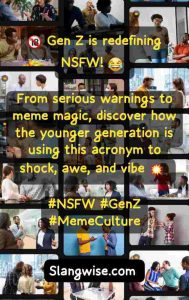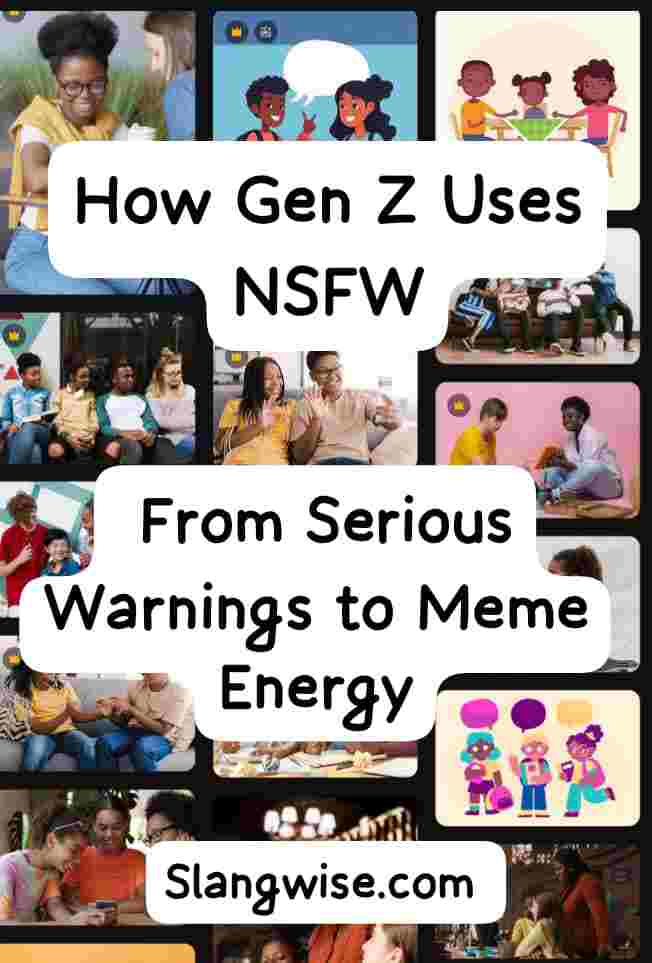NSFW used to be a blunt office-era label: “Not Safe For Work.” Today, it lives in two worlds at once. In one corner it still protects people from shocking or explicit material.
In the other, it has been hijacked, folded into jokes, and turned into meme energy by a generation that speaks in irony and rapid context-switching.
This post maps that split, shows how Gen Z repurposes NSFW, and gives clear rules for when the label actually matters, or when it’s just performative.
Table of Contents
What NSFW means (the baseline)
At its simplest, NSFW is a courtesy. It tells the viewer that what follows might be inappropriate to open in a public or professional setting, nudity, graphic violence, or intensely offensive language.
That basic definition is now part of major dictionaries and reflects how the label functions in everyday life.
For a deed dive on what NSFW really mean in every sense of it, i have here: NSFW Meaning – Learn What NSFW Means in Slang and Why People Use always.
A short history you should know
The tag grew up on forums and early social platforms where users shared links that could get someone into awkward or even disciplinary situations at work.
Over the 2000s it moved into mainstream usage on blogs, message boards, and eventually social apps. That origin, practical, workplace-minded, still shapes how many people use NSFW today.
Stay woke! 😎 Want to decode the secret language of Gen Z? 📚️ Dive into our trending post to uncover the 50 most popular Gen Z slang terms and level up your lingo game!
Two parallel meanings: safety vs. style
Gen Z treats language like clay. That’s why NSFW now carries two distinct signals:
- Safety signal (literal): A real content warning. Use this when something could harm, shock, or embarrass a viewer in public.
- Style signal (ironic/meme): A tone-setting device. Use this like seasoning, it can make a post feel edgy, self-aware, or performatively “too hot to handle” when nothing graphic is actually shown.
Both are real uses. The trick is recognizing which one is in play.
NSFW as meme energy (how irony flips the label)
Gen Z humor leans on layers of irony, meta-irony, and absurdism. Labels like NSFW become part of that toolkit.
People slap NSFW on content that is clearly safe; a squeaky-clean dance video, a silly screenshot, a surreal meme; to create contrast and surprise.
That contrast is where the joke lives: the brain reads the warning, expects something wild, then encounters something mundane or intentionally silly. This flip is a classic Gen Z move: build an expectation, then undercut it for comic effect.
Example (textual): a caption reads “NSFW” above a perfectly wholesome clip of someone making toast. The tag does the comedic work. It’s brief, shareable, and often earns more engagement because people click to see what the mismatch is.
compared to the core meaning of NSFW – You’ve Been Using NSFW Wrong, Here are 7 Surprising Times It Actually Applies,
When ironic NSFW works, and when it backfires
Ironic NSFW works when the audience understands the joke and the platform context supports playful labeling. On private meme pages and among friends, it’s low-risk.
In public forums, at work, or on pages with diverse followers, it can backfire in three ways:
- Misread tone: Older viewers or workplace monitors might take the tag literally and judge the poster.
- Dilution: Overuse turns a useful safety flag into background noise. People stop trusting it.
- Platform rules: Moderation systems and community standards don’t understand irony. A post labeled NSFW might attract enforcement even if the content isn’t explicit.
These pitfalls show why creators who trade in irony must still think through audience and platform before tagging.
NSFW as community shorthand and identity signal
Beyond jokes, NSFW can signal belonging. Within niche corners of the internet, a sarcastic “NSFW” can be shorthand for boundary-pushing aesthetics or for content that flirts with taboo without crossing it.
For some creators, the tag becomes a small identity marker, “this is my kind of edgy,” or “we’re the people who get the joke.” That social function is part of why the label lives on even as its literal meaning loosens.
Real-world examples (how people actually use it)
- Straight warning: A news clip with graphic footage gets a clear NSFW tag so readers can opt out. (Literal use.)
- Ironic caption: A photo of a beige cardigan labeled “NSFW” as a joke — the contrast is the point. (Meme energy.)
- Tone-setting: A creator uses “NSFW — savage honesty” to flag blunt, profanity-heavy takes even if there’s no visual explicitness. (Hybrid use.)
Why Gen Z bends warnings into jokes
Social media is fast and memetic. Gen Z learned to compress meaning into tiny codes, a two-letter tag can carry an entire punchline.
Research into Gen Z’s language habits shows that social platforms are central to how slang spreads and evolves; watching short-form video and meme pages teaches new meanings rapidly.
That dynamic explains why NSFW can mean both warning and wink, often within hours.
Practical rules to use NSFW safely
If the goal is to be both clever and responsible, follow these simple rules:
- Err on the side of clarity when safety matters. If content could harm or trigger viewers, label it plainly and add context (e.g., “NSFW; graphic injury” or “TW: sexual assault”).
- Know your audience. A meme page’s followers will read irony differently than a mixed public feed.
- Don’t rely on the tag to bypass platform rules. Moderation systems enforce content, not intent. Tagging doesn’t grant immunity.
- Use irony sparingly if you value trust. Over-tagging for jokes trains followers to ignore legitimate warnings.
A short ethics note from Slangwise
Irony is fun, but safety matters more. When someone posts a real trauma account, a medical photo, or doxxed personal data, a flippant NSFW is not enough.
These are moments that require clarity, resources, and, where appropriate, moderation. Treat the label as a first step, not a final answer.

Final Thought
Language changes on fast-forward when platforms move at the speed of culture. NSFW’s evolution from a literal office warning to a meme-able wink is a textbook example of how Gen Z retools words for humor, identity, and community.
That doesn’t erase the original purpose. The smartest creators, and the most considerate users hold both meanings in their heads at once: use NSFW to protect people when needed, and deploy it for joke energy only when the audience and platform clearly allow for it.
I track these shifts across platforms and write about them so creators and readers make better tagging choices. I recommend keeping the tag’s core function intact: it should protect first, amuse second.

